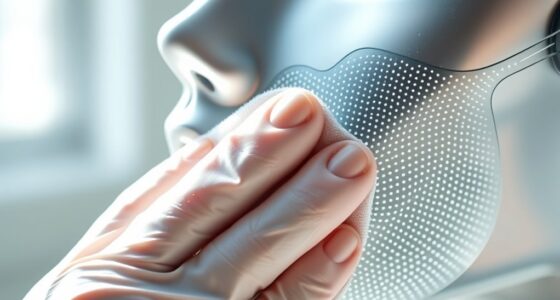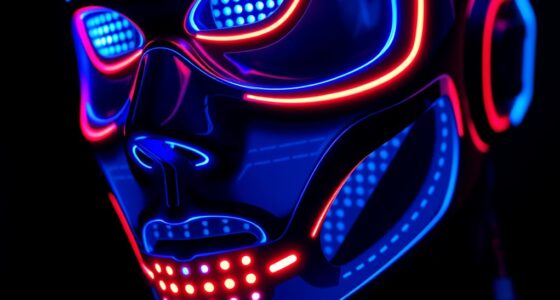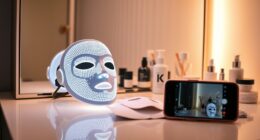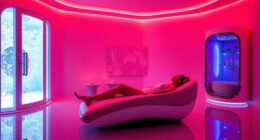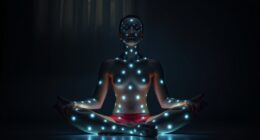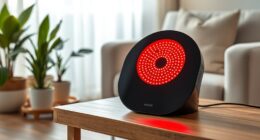In tri-wave masks, blue, red, and near-infrared LEDs work together to target different skin layers for ideal results. Blue light clears bacteria and reduces inflammation on the surface, red light stimulates collagen and improves firmness deeper down, and near-infrared penetrates even further to support tissue repair and deep healing. By combining these wavelengths, the mask offers a holistic treatment that boosts skin health at multiple levels. Keep exploring to discover how this synergy can elevate your skincare routine.
Key Takeaways
- The three wavelengths target different skin layers: blue for surface bacteria, red for dermal collagen, near-infrared for deep tissue repair.
- Combining wavelengths provides a multi-layered treatment, enhancing overall skin rejuvenation and addressing multiple skin concerns.
- Blue LEDs clear breakouts and reduce inflammation, while red and near-infrared promote collagen production and cellular healing.
- The synergy of blue, red, and near-infrared LEDs amplifies treatment effectiveness by stimulating various biological processes simultaneously.
- A tri-wave mask leverages wavelength interactions to optimize skin clarity, firmness, and deep tissue health in a comprehensive skincare approach.

Tri-wave masks utilize blue, red, and near-infrared LEDs working together to target different skin layers and achieve holistic skin rejuvenation. This combination harnesses LED synergy, where each wavelength interacts uniquely with your skin’s cells to produce extensive improvements. When you use a tri-wave mask, you’re tapping into the power of wavelength interactions—an essential factor that enhances the overall effectiveness of the treatment.
Tri-wave masks combine blue, red, and near-infrared LEDs for multi-layered skin rejuvenation and enhanced treatment effectiveness.
The blue LEDs operate at a shorter wavelength, typically around 415 nm, penetrating only the uppermost skin layers. This makes them excellent for targeting bacteria that cause acne and reducing inflammation. The blue light’s ability to reach superficial skin areas means it can clear breakouts and calm irritated skin effectively. It’s like giving your skin a deep cleanse from within, helping to balance oil production and prevent future breakouts.
Red LEDs, usually around 630-660 nm, penetrate deeper into the skin, reaching the dermis—the layer where collagen and elastin fibers reside. This wavelength stimulates cellular activity, boosting collagen production and enhancing blood circulation. When you use the red light, you’re encouraging your skin’s natural healing processes, which can lead to smoother, firmer, and more elastic skin over time. The interaction of this wavelength with skin tissues promotes tissue repair and reduces fine lines and wrinkles, making your skin appear more youthful.
Near-infrared LEDs, which operate at approximately 800-880 nm, penetrate even deeper than red light, reaching muscle tissues, joints, and deeper skin layers. This wavelength is particularly effective for reducing inflammation and promoting cellular regeneration at a more profound level. When combined with red and blue light, near-infrared LEDs enhance overall skin health by supporting the skin’s repair mechanisms from within. Their deeper wavelength interactions foster a holistic approach to skin rejuvenation, targeting issues that surface treatments alone might not fully address.
The beauty of a tri-wave mask lies in how these different wavelengths complement each other. The synergy of blue, red, and near-infrared LEDs creates a multi-layered approach to skin health. Each wavelength interacts with your skin’s tissues in a way that amplifies the benefits of the others, resulting in a more comprehensive outcome. This coordinated wavelength interaction ensures that your skin receives targeted care at every layer, from surface bacteria reduction to deep tissue regeneration. By understanding and leveraging these interactions, you maximize the potential of your LED therapy, achieving clearer, firmer, and healthier skin with consistent use. Additionally, understanding the wavelength interactions involved can help optimize treatment outcomes.
Frequently Asked Questions
How Long Do Tri-Wave Mask LED Treatments Typically Last?
Tri-wave mask LED treatments usually last around 10 to 20 minutes per session, depending on your skin’s needs. The treatment duration is designed to maximize benefits without overexposure. As for LED lifespan, most LEDs in these masks typically last between 30,000 to 50,000 hours of use. This guarantees you can enjoy many treatments over time without worrying about the LEDs fading or losing effectiveness.
Are There Any Side Effects From Using Tri-Wave Masks?
You might worry about side effects, but most users find tri-wave masks safe and gentle. While some experience minor skin irritation or photosensitivity reactions, these are usually temporary and manageable. To minimize risks, follow the recommended treatment guidelines and avoid overuse. If you have sensitive skin or concerns, consult a dermatologist beforehand. Overall, with proper use, you can enjoy the benefits without significant side effects.
Can Tri-Wave Masks Be Used on All Skin Types?
You might wonder if tri-wave masks suit all skin types. Generally, LED technology is quite versatile, making it compatible with most skin tones. However, skin compatibility varies depending on individual sensitivities or conditions. It’s best to do a patch test first or consult a dermatologist. Most people can safely use these masks, but those with very sensitive or problematic skin should take extra precautions before starting regular treatments.
How Often Should I Use a Tri-Wave Mask for Best Results?
For the best results, you should follow the recommended frequency guidelines provided with your tri-wave mask. Typically, using it 3 to 4 times a week is effective for maintenance and skin improvement. Consistency is key, so incorporate it into your skincare routine regularly. Remember to follow maintenance tips like cleaning your mask properly and avoiding overuse to prevent irritation and maximize benefits.
Are Tri-Wave Masks Safe for Sensitive or Damaged Skin?
You wonder if tri-wave masks are safe for sensitive or damaged skin. While they’re generally designed for safe use, skin sensitivity and damage can vary. It’s essential to take into account device safety and start with shorter sessions, watching for irritation. If your skin is compromised, consult a dermatologist before use. Always follow manufacturer instructions, as proper usage minimizes risks and ensures a gentle, effective treatment tailored to your skin’s needs.
Conclusion
By combining blue, red, and near-infrared LEDs in tri-wave masks, you harness a powerful synergy that boosts your skincare routine. These lights work together like a well-oiled machine, penetrating different skin layers for maximum benefit. Don’t forget, it’s all about working smarter, not harder, so you get the best results without breaking a sweat. With this technology, you’re set to glow from the inside out—your skin’s best friend in shining armor.


